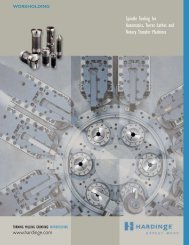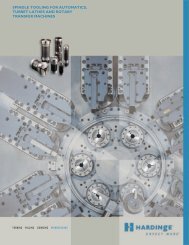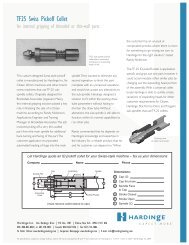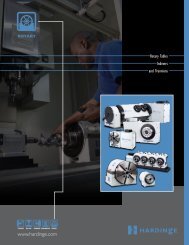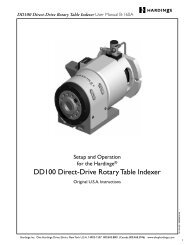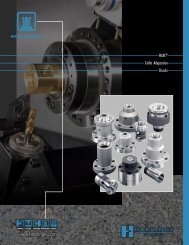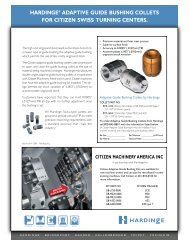Hardinge Custom Workholding Solutions
Hardinge Custom Workholding Solutions
Hardinge Custom Workholding Solutions
Create successful ePaper yourself
Turn your PDF publications into a flip-book with our unique Google optimized e-Paper software.
Over-The-Shoulder<br />
• When you have to clear a shoulder and grip<br />
on a smaller diameter, an over-the-shoulder<br />
collet may be used. These collets are usually<br />
standard as pick-off collets on automatic<br />
screw machines. This style collet can also be<br />
used on CNC lathes that have a long draw<br />
bar stroke. –see sample page 5<br />
• These collets are multi-slotted and double<br />
angled. The closing angle is very short and<br />
the opening angle is very steep. The collet<br />
requires an extremely large spread and is<br />
only practical for light machining operations<br />
such as face, chamfer, etc.<br />
Round Off-The-Spindle Fixturing<br />
• Several fixtures are made with round chucking<br />
surfaces. The chucking diameter of the<br />
fixtures are held within .0002" of each other.<br />
The bore of the step chuck is made to the<br />
same diameter as the chucking diameter of<br />
the round fixtures.<br />
• While one part is running in the machine, another<br />
fixture can be loaded to reduce setup<br />
time.<br />
• The critical lengths are controlled because the<br />
chucking diameters of the round fixtures are<br />
held to within a couple ten thousandths. Holding<br />
lengths to .001" are the accepted norm.<br />
1 8 – C U S T O M C O L L E T S T Y L E S<br />
If closer length tolerances are required, pins can<br />
be used in the step chuck and closer assembly.<br />
<strong>Custom</strong> Serrations<br />
• Serrations add 10% additional gripping<br />
power using the same draw bar pressure<br />
– popular round serrated collet sizes are<br />
standard.<br />
• They can help prevent push-back and radial<br />
slipping during heavy forming or drilling.<br />
• Serrations can be made in circular, buttress,<br />
diamond, tap and tapered flat (for draft angles).<br />
–see sample page 16<br />
Special Shape<br />
• Special shape collets are used for precision<br />
cast parts and molded products.<br />
• Many of these collets are made using the<br />
EDM process. –see sample page 6<br />
• Contour milling may also be done using a<br />
CNC VMC mill or a precision jig boring /<br />
grinding machine. Part size is only limited by<br />
the machine tool’s capabilities.<br />
Stepped, Single & Multi-Stepped<br />
• This style collet locates the part a specific distance<br />
from the face of the collet. It eliminates<br />
push back of the stock but does not control<br />
lengths due to stock diameter variations.<br />
• A single-stepped may have a thru-hole to<br />
grip on the shank of a part during the first<br />
operation or it may be a clearance hole for a<br />
drill or boring tool.<br />
• Multi-stepped are used when end-for-ending<br />
the workpiece.<br />
Synchronized Collets<br />
• A synchronized collet is used when a point<br />
on the part has to align with the center of<br />
the keyway of the collet. Hex and square<br />
collets are synchronized to the center of the<br />
flat or the corner. Some standard collets for<br />
specific machines are already synchronized.<br />
Tapered<br />
• Taper styles include regular Morse, Jacobs<br />
and custom tapers, as well as reverse taper.<br />
Threaded<br />
• Threaded collets can be ordered in solid,<br />
3-split and 4-split.<br />
See pages 20-23 to assist you in obtaining a quote for your<br />
required workholding device.



